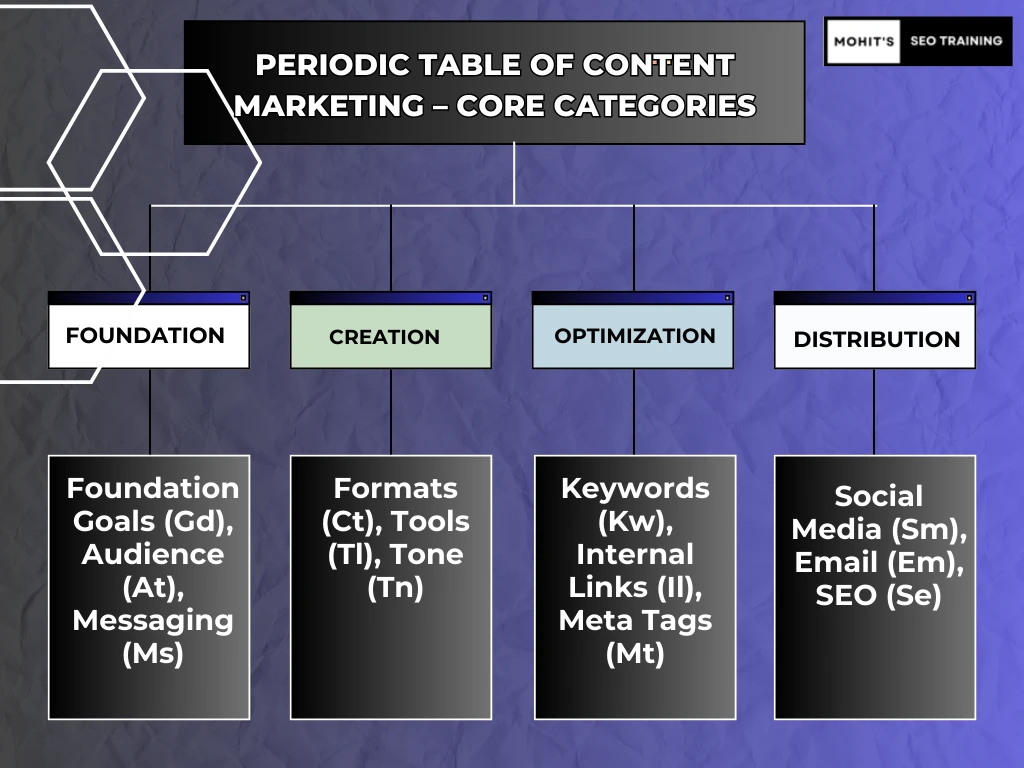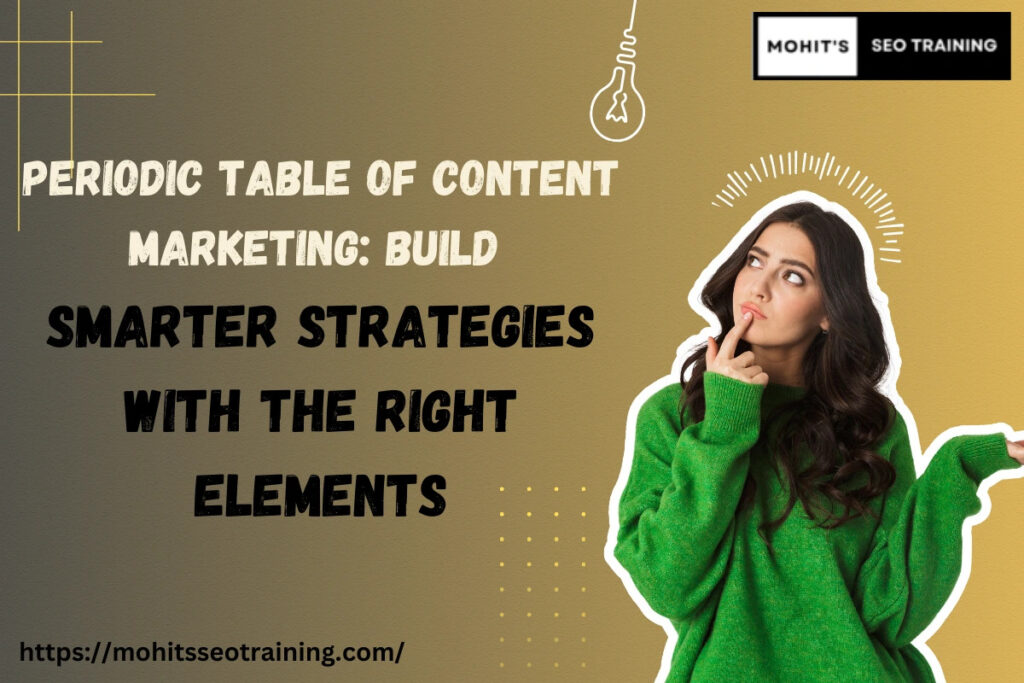Remember that periodic table from your school days? The one with all the chemical elements, neatly arranged in rows and columns? Back then, it seemed like a puzzle only scientists could solve. But guess what? That very idea has found a second home — in digital marketing.
Today, we use our own version of that structure: the periodic table of content marketing. For students entering the SEO field or the experienced SEO managers who are content to work off an existing framework, this table provides a visual, strategic and structured way to organize content and boost your SEO performance.
Let’s take a deeper dive into this evolving concept – including how it relates to the periodic table of SEO, its elements, use cases and what makes it more relevant than ever in 2025.
Main points of this blog are:
Periodic table of content marketing
Fundamental elements of periodic table
Content type and their place on periodic table
Importance of periodic table
What is the content of the periodic table?
The periodic table of content marketing is made up of strategic content elements organized into logical clusters.
These components include goals, audience types, content formats, optimization strategies, distribution methods, and performance metrics. Every component plays a role in creating a comprehensive content marketing strategy.
Periodic Table of Content Marketing – Core Categories
| Category | Elements Included |
| Foundation | Goals (Gd), Audience (At), Messaging (Ms) |
| Creation | Formats (Ct), Tools (Tl), Tone (Tn) |
| Optimization | Keywords (Kw), Internal Links (Il), Meta Tags (Mt) |
| Distribution | Social Media (Sm), Email (Em), SEO (Se) |
| Measurement | Time on Page (Tp), Bounce Rate (Br), Shares (Sh) |
What is the concept of periodic table?
Just like the chemical periodic table organizes elements based on their properties, the content marketing version brings order to the often-chaotic world of digital strategy. It helps you visualize and plan content creation, SEO integration, and distribution workflows in a methodical way.
What are types of the periodic table?
In marketing, we use variations such as:
Periodic Table of SEO: Covers ranking factors like on-page SEO, content quality, backlinks, and site speed.
SEO Table of Elements: A simplified or visual-friendly version of the SEO table.
Periodic Table of Content Marketing: Focuses on content strategy, formats, audiences, and measurement.
What are the fundamental components of the Periodic Table of Content Marketing?
The Role of Architecture Here’s a quick introduction to some standard elements and their components:
- Gd – Goals: Define what your content aims to achieve.
- At – Audience: Who the content is for.
- Ct – Content Type: Blog, video, carousel, etc.
- Tn – Tone of Voice: Friendly, formal, authoritative.
- Kw – Keywords: SEO-focused terms for discoverability.
- Il – Internal Links: Site structure and content connection.
- Se – SEO: On-page and technical SEO.
- Sm – Social Media: Promotion on platforms.
- Em – Email: Direct distribution to inboxes.
- Tp – Time on Page: Engagement indicator.
Why is the periodic table important?
The periodic table format helps marketers and SEO professionals in several impactful ways:
- Stay organized and strategic: With so many content elements like audience targeting, SEO optimization, tone, and distribution channels, it’s easy to overlook essential parts. The table acts like a checklist and framework that brings clarity and structure to the entire process.
- Align multiple teams and departments: Content marketing involves writers, designers, SEOs, developers, and sometimes sales teams. A periodic table creates a common language for all departments, ensuring everyone understands their role and works in sync toward the same goal.
- Quickly identify missing or underperforming areas: During content audits or strategy reviews, the table helps you spot gaps like missing CTAs, unclear goals, or weak distribution strategies. This makes your troubleshooting more efficient and less guess-based.
- Scale content efforts more effectively: As your business grows, so does your content workload. The table helps standardize your process, making it easier to delegate, automate, and scale without losing consistency or quality.
With so many moving parts in digital marketing, this structured format acts as a visual dashboard—making sure nothing important falls through the cracks.

How to Build Your Own Periodic Table of Content
Start with Your Business Goals (Gd): Awareness, engagement, leads, or conversions.
Define Your Audience (At): Use personas to tailor tone and messaging.
Choose the Right Content Formats (Ct): Blogs, reels, podcasts, etc.
Add SEO Elements (Kw, Se, Mt): Use tools like SEMrush or Ahrefs to find terms.
Plan Distribution (Sm, Em): Based on where your audience is most active.
Assign Measurement KPIs (Tp, Br, Cv): Set up proper tracking in GA4 or similar.
Content Types and Their Place on the Table (Explained with Example)
Think of the table as having different “families” or clusters, much like in chemistry:
- Foundation Elements: Goals, audience, messaging
- Creation Elements: Formats, tools, tone of voice
- Optimization Elements: Keywords, internal links, meta tags
- Distribution Elements: Social media, email, SEO
- Measurement Elements: Engagement, bounce rate, conversions
- Example: Imagine you’re launching a blog series for a skincare brand targeting Gen Z.
- Foundation: Your goal (Gd) is brand awareness. Audience (At) is Gen Z skincare beginners. Messaging (Ms) is simple and friendly.
- Creation: You choose blog posts (Ct), write in a casual tone (Tn), and use Canva for visuals (Tl).
- Optimization: Use long-tail keywords (Kw) like “best skincare routine for teens”, optimize images (Im), and add internal links (Il).
- Distribution: Promote via Instagram (Sm), weekly emails (Em), and SEO (Se).
- Measurement: Track time on page (Tp), bounce rate (Br), and shares (Sh).
By mapping this strategy across the table, every part of the campaign has a purpose and place.
Final Thoughts
The periodic table for SEO and content marketing aren’t just pretty charts, they’re strategic blueprints. In a time where attention is short and competition is fierce, having a clear, structured plan is what separates noise from impact.
So whether you’re mapping out a campaign or starting your first blog, pull up your periodic table and let strategy guide your creativity.
FAQs
What is the difference between the periodic table of SEO and content marketing?
The SEO table focuses on ranking factors, while the content marketing table is about planning and structuring high-value content.
Is the periodic table model still relevant in 2025?
Absolutely. With content overload and AI-generated text, structure and clarity are more important than ever.
Can beginners use the periodic table model?
Yes. It’s especially helpful for students, interns, and new marketers to understand the bigger picture.
How can I access or create my own periodic table?
You can download templates online or create your own using tools like Canva or Miro.
Does this framework apply to all industries?
Yes. Whether B2B, B2C, or D2C, the principles of structured content marketing hold true.
Mohit Verma
I am an experienced professional with 9+ years of experience in Search Engine Optimization. I am on a mission to provide industry focused job oriented SEO so the students/mentees can get their dream SEO job and and start working from day 1.
